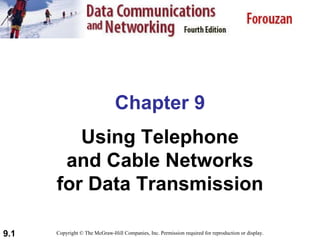
Ch09
- 1. Chapter 9 Using Telephone and Cable Networks for Data Transmission Copyright © The McGraw-Hill Companies, Inc. Permission required for reproduction or display.
- 2. 9-1 TELEPHONE NETWORK Telephone networks use circuit switching. The telephone network had its beginnings in the late 1800s. The entire network, which is referred to as the plain old telephone system ( POTS ), was originally an analog system using analog signals to transmit voice. Major Components LATAs Signaling Services Provided by Telephone Networks Topics discussed in this section:
- 3. Figure 9.1 A telephone system
- 4. Intra-LATA services are provided by local exchange carriers. Since 1996, there are two types of LECs: incumbent local exchange carriers and competitive local exchange carriers. Note
- 5. Figure 9.2 Switching offices in a LATA
- 6. Figure 9.3 Point of presences (POPs)
- 7. The tasks of data transfer and signaling are separated in modern telephone networks: data transfer is done by one network, signaling by another. Note
- 8. Figure 9.4 Data transfer and signaling networks
- 9. Figure 9.5 Layers in SS7
- 10. 9-2 DIAL-UP MODEMS Traditional telephone lines can carry frequencies between 300 and 3300 Hz, giving them a bandwidth of 3000 Hz. All this range is used for transmitting voice, where a great deal of interference and distortion can be accepted without loss of intelligibility. Modem Standards Topics discussed in this section:
- 11. Figure 9.6 Telephone line bandwidth
- 12. Modem stands for modulator/demodulator. Note
- 13. Figure 9.7 Modulation/demodulation
- 14. Figure 9.8 The V.32 and V.32bis constellation and bandwidth
- 15. Figure 9.9 Uploading and downloading in 56K modems
- 16. 9-3 DIGITAL SUBSCRIBER LINE After traditional modems reached their peak data rate, telephone companies developed another technology, DSL, to provide higher-speed access to the Internet. Digital subscriber line ( DSL ) technology is one of the most promising for supporting high-speed digital communication over the existing local loops. ADSL ADSL Lite HDSL SDSL VDSL Topics discussed in this section:
- 17. ADSL is an asymmetric communication technology designed for residential users; it is not suitable for businesses. Note
- 18. The existing local loops can handle bandwidths up to 1.1 MHz. Note
- 19. ADSL is an adaptive technology. The system uses a data rate based on the condition of the local loop line. Note
- 20. Figure 9.10 Discrete multitone technique
- 21. Figure 9.11 Bandwidth division in ADSL
- 22. Figure 9.12 ADSL modem
- 23. Figure 9.13 DSLAM
- 24. Table 9.2 Summary of DSL technologies
- 25. 9-4 CABLE TV NETWORKS The cable TV network started as a video service provider, but it has moved to the business of Internet access. In this section, we discuss cable TV networks per se; in Section 9.5 we discuss how this network can be used to provide high-speed access to the Internet. Traditional Cable Networks Hybrid Fiber-Coaxial (HFC) Network Topics discussed in this section:
- 26. Figure 9.14 Traditional cable TV network
- 27. Communication in the traditional cable TV network is unidirectional. Note
- 28. Figure 9.15 Hybrid fiber-coaxial (HFC) network
- 29. Communication in an HFC cable TV network can be bidirectional. Note
- 30. 9-5 CABLE TV FOR DATA TRANSFER Cable companies are now competing with telephone companies for the residential customer who wants high-speed data transfer. In this section, we briefly discuss this technology. Bandwidth Sharing CM and CMTS Data Transmission Schemes: DOCSIS Topics discussed in this section:
- 31. Figure 9.16 Division of coaxial cable band by CATV
- 32. Downstream data are modulated using the 64-QAM modulation technique. Note
- 33. The theoretical downstream data rate is 30 Mbps. Note
- 34. Upstream data are modulated using the QPSK modulation technique. Note
- 35. The theoretical upstream data rate is 12 Mbps. Note
- 36. Figure 9.17 Cable modem (CM)
- 37. Figure 9.18 Cable modem transmission system (CMTS)
